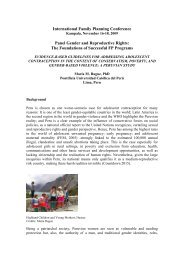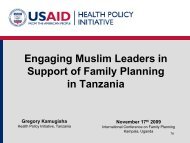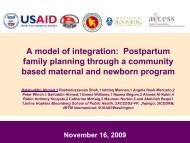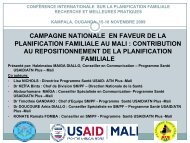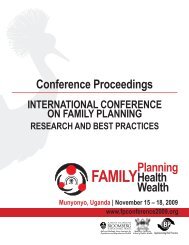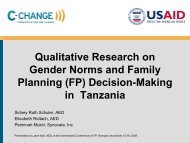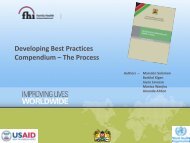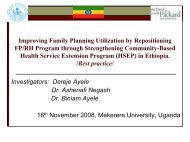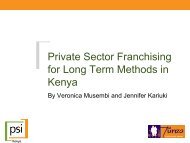male involvement in family planning decision making in ile-ife, osun ...
male involvement in family planning decision making in ile-ife, osun ...
male involvement in family planning decision making in ile-ife, osun ...
You also want an ePaper? Increase the reach of your titles
YUMPU automatically turns print PDFs into web optimized ePapers that Google loves.
MALE INVOLVEMENT IN FAMILY<br />
PLANNING DECISION MAKING IN ILE‐IFE,<br />
OSUN STATE.<br />
IJADUNOLA MACELLINA YINYINADE (M.D, M.P.H),<br />
IJADUNOLA K.T, ABIONA T.C, ESIMAI O.A, AFOLABI O.T<br />
OBAFEMI AWOLOWO UNIVERSITY, ILE‐IFE<br />
THE INTERNATIONAL CONFERENCE ON FAMILY PLANNING<br />
RESEARCH AND BEST PRACTICES<br />
NOVEMBER 15‐18, 2009<br />
KAMPALA, UGANDA
BACKGROUND<br />
• Nigeria is the most populous country <strong>in</strong> sub‐<br />
Saharan Africa, with a population of 140<br />
million people <strong>in</strong> 2006<br />
• Contemporary research f<strong>in</strong>d<strong>in</strong>gs revealed that<br />
men's’ knowledge and attitude about FP<br />
<strong>in</strong>fluence women’s choices and practices<br />
• Fertility and FP research and programmes<br />
have ignored men’s roles <strong>in</strong> the past, focus<strong>in</strong>g<br />
on women<br />
12/13/2009 2
Study Aim<br />
• To determ<strong>in</strong>e the extent of <strong>male</strong><br />
<strong><strong>in</strong>volvement</strong> <strong>in</strong> reproductive goal <strong>decision</strong><br />
mak<strong>in</strong>g and FP service utilization among<br />
couples <strong>in</strong> Ile‐Ife, Nigeria<br />
12/13/2009 3
Objectives<br />
• Assess men’s knowledge, attitude, practice of<br />
modern contraceptive methods<br />
• Assess the level of spousal communication <strong>in</strong><br />
FP <strong>decision</strong> mak<strong>in</strong>g<br />
• Describe the op<strong>in</strong>ions of FP providers toward<br />
<strong>male</strong> participation <strong>in</strong> RH services<br />
12/13/2009 4
• Study location<br />
Methodology<br />
• Study design: Quantitative (Cross‐sectional)<br />
and qualitative (FGDs and IDIs) methods<br />
• Study population<br />
• Sample size: 400 <strong>male</strong>s, 200 fe<strong>male</strong>s<br />
12/13/2009 5
OBJECTIVE<br />
OBJECTIVE 1:<br />
Assess me n’s<br />
knowledge, attitudes,<br />
and practice of modern<br />
contraceptive methods.<br />
OBJECTIVE 2:<br />
Assess the level of<br />
spousal communication<br />
<strong>in</strong> <strong>family</strong> plann<strong>in</strong>g<br />
<strong>decision</strong> mak<strong>in</strong>g.<br />
OBJECTIVE 3:<br />
Exam<strong>in</strong>e the attitudes<br />
of <strong>family</strong> plann<strong>in</strong>g<br />
providers toward <strong>male</strong><br />
participation <strong>in</strong><br />
reproductive health<br />
services.<br />
Methodology<br />
POPULATION TO BE<br />
STUDIED METHODS TO BE USED SAMPLE SIZE<br />
Men of reproductive age<br />
group 15-59 years<br />
•Men with<strong>in</strong> the age group<br />
15-59yrs<br />
•Women of Reproductive<br />
age group 15-49 years<br />
Heads of <strong>family</strong> plann<strong>in</strong>g<br />
service units <strong>in</strong> selected<br />
health facilities <strong>in</strong> Ile-Ife.<br />
Structured Household<br />
questionnaires<br />
Structured Household<br />
questionnaires and Focus Group<br />
Discussions.<br />
Focus groups were assembled based<br />
on sex, religious affiliation<br />
(Christianity / Islam), age (young<br />
adults and older adults), educational<br />
status (primary education or less &<br />
secondary/tertiary)<br />
•One In-depth Interview per facility<br />
•Review of facility <strong>family</strong> plann<strong>in</strong>g<br />
service registers<br />
402 Structured<br />
Household<br />
questionnaires<br />
12/13/2009 6<br />
•<br />
•<br />
•<br />
402 <strong>male</strong> household<br />
questionnaires<br />
201 fe<strong>male</strong><br />
household<br />
questionnaires<br />
Twelve focu s<br />
groups, each group<br />
consist<strong>in</strong>g of about<br />
8-10 participants.<br />
A Tertiary health facility,<br />
2 secondary health<br />
facilities, 3 Primary<br />
Health Care centre and 4<br />
Private Health facilities<br />
<strong>in</strong> Ile- Ife.
RESULTS<br />
• Age distribution for men ranged between 18‐<br />
59 years >two‐thirds 4th & 5th decades of l<strong>ife</strong><br />
• Majority (84%) were <strong>in</strong> monogamous unions,<br />
wh<strong>ile</strong> others (16%) were <strong>in</strong> polygamous union<br />
• Almost 3% of men and about same proportion<br />
of all respondents had never been to school<br />
wh<strong>ile</strong> about 80% had atta<strong>in</strong>ed secondary or<br />
higher levels of education.<br />
12/13/2009 7
Table 1: Awareness of Survey Respondents<br />
about Modern Family plann<strong>in</strong>g Methods<br />
Awareness of Modern Male<br />
Fe<strong>male</strong> Total<br />
Contraceptive Method n=400 (%) n=200 (%) n=600 (%)<br />
Yes 399 (99.8) 198 (99.0) 597 (99.5)<br />
No 1 (0.2) 2 (1.0) 3 (0.5)<br />
*Source of Information Male<br />
Fe<strong>male</strong> Total<br />
n=399 (%) n=198 (%) n=597 (%)<br />
Radio 371 (93.0) 174 (87.9) 545 (91.3)<br />
Friends 354 (88.7) 158 (79.8) 512 (85.8)<br />
Television<br />
Health workers <strong>in</strong> <strong>family</strong><br />
327 (82.0) 155 (78.3) 482 (80.7)<br />
plann<strong>in</strong>g cl<strong>in</strong>ic/Hospitals 55 (13.8) 76 (38.3) 131 (21.8)<br />
Books/Journals 9 (2.3) 10 (5.1) 19 (3.2)<br />
12/13/2009 8
Men's attitude about spousal use of<br />
Family Plann<strong>in</strong>g, Ile-Ife<br />
Approve<br />
89%<br />
70<br />
60<br />
50<br />
40<br />
30<br />
20<br />
10<br />
0<br />
Men's practice regard<strong>in</strong>g attend<strong>in</strong>g<br />
FP Cl<strong>in</strong>ics with Spouse, Ile-Ife<br />
Percentage<br />
80<br />
26<br />
Yes<br />
74<br />
No<br />
Ever attended FP Cl<strong>in</strong>ic<br />
Disapprove<br />
11%<br />
11%<br />
12/13/2009 9
Quotes from FGD Participants<br />
• “What will I do <strong>in</strong> a <strong>family</strong> plann<strong>in</strong>g cl<strong>in</strong>ic, the place is<br />
not meant for men, it is ridiculous for men to be<br />
there, I will just give my w<strong>ife</strong> the necessary f<strong>in</strong>ancial<br />
support she needs” (Educated man, 30‐55 years).<br />
• “My husband has never accompanied me to <strong>family</strong><br />
plann<strong>in</strong>g cl<strong>in</strong>ic. He only gave me money for the<br />
method I decided to use” (Uneducated woman, 18‐<br />
30 years)<br />
12/13/2009 10
Table 2. Reported reasons for approval/disapproval of<br />
Spousal use of Family Plann<strong>in</strong>g Methods<br />
Male<br />
Fe<strong>male</strong><br />
Total<br />
Approve<br />
n=357 (%) n=186 (%) n=543 (%)<br />
Space Birth 255 (71.4) 124 (66.7) 379 (69.8)<br />
Achieve desired <strong>family</strong> size 72 (20.1) 36 (19.4) 108 (19.9)<br />
Avoid unwanted pregnancy 15 (4.2) 11 (5.9) 26 (4.8)<br />
Promote child health 7 (2.0) 12 (6.4) 19 (3.5)<br />
Improve quality of child care 7 (2.0) 2 (1.1) 9 (1.6)<br />
Marital bliss 1 (0.3) 1 (0.5) 2 (0.4)<br />
Total 357 (100) 186 (100) 543 (100)<br />
Male<br />
Fe<strong>male</strong><br />
Total<br />
Disapprove<br />
n=43 (%) n=14 (%) n=57 (%)<br />
Religion 19 (44.1) 3 (21.4) 22 (38.4)<br />
Side effects 14 (30.5) 3 (21.4) 17 (28.7)<br />
Encourage <strong>in</strong>fidelity 9 (20.8) 5 (35.8) 14 (24.3)<br />
Reason unstated 2 (4.6) 3 (21.4) 5 (8.6)<br />
Total 43 (100) 14 (100) 57 (100)<br />
12/13/2009 11
Utilization of Family Plann<strong>in</strong>g methods by <strong>male</strong> survey<br />
respondents <strong>in</strong> Ile-Ife<br />
Percentage<br />
100<br />
80<br />
60<br />
40<br />
20<br />
0<br />
81.3<br />
18.7<br />
12/13/2009 12<br />
55.5<br />
Ever use Current use<br />
Yes No<br />
44.5
Initiator of discussion about reproductive issues among survey<br />
respondents<br />
Percentage<br />
30<br />
20<br />
10<br />
0<br />
15.5<br />
9.5<br />
13.5<br />
13.4<br />
12/13/2009 13<br />
5<br />
20.5<br />
When to achieve pregnancy When to avoid pregnancy Use of contraceptives<br />
Men Women
Figure 5: Spousal Communication about Family Plann<strong>in</strong>g <strong>in</strong><br />
the past Year<br />
Percentage<br />
60<br />
50<br />
40<br />
30<br />
20<br />
10<br />
0<br />
34.7<br />
38<br />
48.5<br />
40<br />
12/13/2009 14<br />
16<br />
Never Once/Twice Thrice<br />
No. of times Family Plann<strong>in</strong>g discussed<br />
22<br />
Male<br />
Fe<strong>male</strong>
Table 3. Family Plann<strong>in</strong>g providers’ perspectives on reasons<br />
why<br />
men do not patronize <strong>family</strong> plann<strong>in</strong>g services, Ile‐Ife,<br />
Reason Percentage<br />
of providers<br />
Cultural norms 100<br />
Society perceives it as a woman’s bus<strong>in</strong>ess 100<br />
Religion dictates 100<br />
Men are self-centered 50<br />
Women are more <strong>in</strong>formed than men about it 50<br />
Men are less committed as <strong>in</strong>dividuals to the <strong>family</strong> 50<br />
12/13/2009 15
CONCLUSIONS<br />
• Men <strong>in</strong> Ile‐Ife possessed adequate knowledge<br />
of modern <strong>family</strong> plann<strong>in</strong>g methods<br />
• Men’s attitude toward and practice of modern<br />
<strong>family</strong> plann<strong>in</strong>g methods was fair<br />
• Level of spousal communication about <strong>family</strong><br />
plann<strong>in</strong>g was poor and the role of men <strong>in</strong><br />
<strong>in</strong>itiat<strong>in</strong>g discussions about contraceptive use<br />
was equally poor<br />
12/13/2009 16
RECOMMENDATIONS<br />
• Based on the f<strong>in</strong>d<strong>in</strong>gs of this study, the<br />
follow<strong>in</strong>g recommendations are made:<br />
– There is a need for more <strong>male</strong> targeted<br />
<strong>in</strong>formation <strong>in</strong> the mass media<br />
– Need to build partnerships<br />
– Hir<strong>in</strong>g of <strong>male</strong> service providers<br />
– Improved social market<strong>in</strong>g of <strong>family</strong> plann<strong>in</strong>g<br />
commodities<br />
– Community‐based resource persons<br />
12/13/2009 17
ACKNOWLEDGMENT<br />
• Study respondents<br />
• Fellow researchers<br />
• O.A.U/J.H.U Bill and Mel<strong>in</strong>da Gates<br />
Partnership Program on Population and<br />
reproductive Health<br />
12/13/2009 18
THANK YOU<br />
12/13/2009 19



